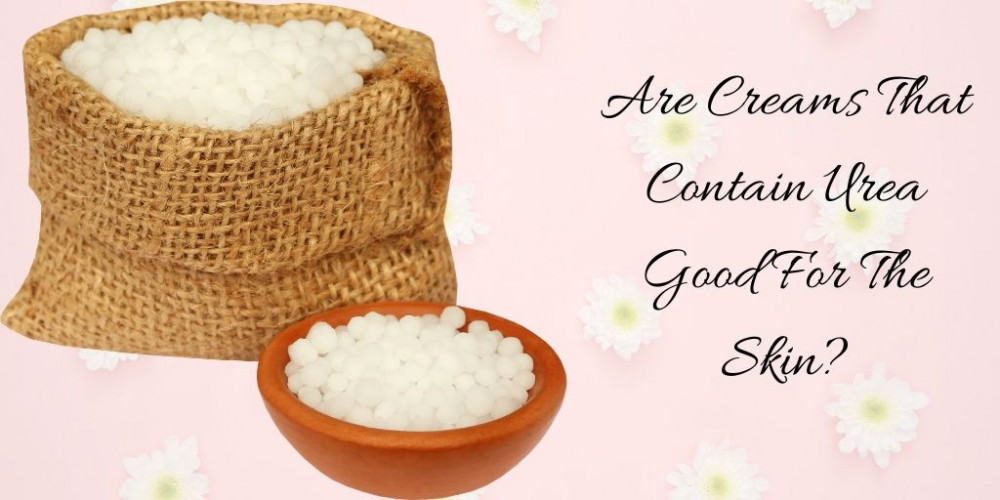Are creams that contain urea good for the skin? You may be scratching your head wondering what urea is. Many people haven’t heard of it in regard to skin care. Urea is a component of the natural moisturizing factor (NMF) in the skin. It’s also an emollient and humectant, meaning it keeps the skin supple, smooth, and hydrated. Keep reading to learn more of the remarkable benefits of this under-appreciated ingredient.
Table of Contents
What Is Urea?
Urea is a product of protein breakdown and metabolism in the body. It’s also called BUN or blood urea nitrogen. You’re probably familiar with that term if you’ve ever had a complete blood chemistry taken. While urea is a component of urine, it also occurs naturally on the surface of the skin to maintain moisture balance, and can be produced synthetically using carbon dioxide and ammonia.
Why is urea good for the skin? Well, for starters it’s an incredible hydrator. This is a huge because when your skin is dehydrated, your complexion looks dull, dry, and worn out. Dehydration leads to premature aging. Urea is a secret weapon against aging because of its ability to deeply moisturize the skin and keep it supple. Supple skin looks fresh and youthful.
Urea is highly beneficial as a moisturizer because of its affinity to bind water and to gently exfoliate the skin, which can become tight and flaky when levels of urea are low. Urea also enhances the absorption of ingredients in cosmetics and beauty care products. Synthetic versions of urea, called carbamide, are used to treat conditions, such as psoriasis and eczema.
Carbamide promotes wound healing due to its keratolytic effects. This means it is able to dissolve keratin, a key protein in the epidermis and a building block of skin, hair, and nails. Dr. Albert M. Kligman, the dermatologist who helped invent Retin-A and establish the dangers of sun-exposure, was also responsible for rediscovering urea.
10 Benefits Of Creams That Contain Urea
Urea is used in moisturizers and cleansers, shampoos and conditioners, anti-aging creams, acne treatments, and makeup. It’s an ingredient in creams, gels, lotions, liquids, and ointments. When used in personal care products, urea minimizes changes in pH, prevents moisture loss, and extends the shelf life. Other benefits include:
1. Urea is hydrophilic and moisturizes on a cellular level. Because it can penetrate the stratum corneum, urea increases the skin’s ability to create and maintain moisture.
2. Products with urea promote healthy barrier function in the skin, which provides protection between the environment and the body. The lipids in the stratum corneum are key to this barrier functioning properly. Urea creates lipids that fortify the barrier, and protect against external influences that are dehydrating. Urea also increases the barrier’s capacity to regenerate.
3. Urea is antimicrobial and inhibits yeast. Many skin conditions are caused by a nasty yeast called malassezia. In vitro studies have shown that urea inhibits malassezia.
4. It’s a natural humectant and emollient. Urea binds moisture from the air to hydrate and soften the skin.
5. A powerful keratolytic and exfoliator, urea regulates the cell cycle in the skin to eliminate dead skin cells and replace them with healthy, new ones. It also breaks the hydrogen bonds that exist in the stratum corneum, which loosens and softens the keratin in the top layer of the skin.
6. Urea balances the bacteria that lives on the skin, and promotes homeostasis, by boosting the production of a protein called filaggrin.
7. Urea may prevent fungal acne by stimulating LL-37, an antimicrobial peptide that is thought to destroy the bacteria that causes acne.
8. Carbamide promotes wound healing by rapidly permeating the cell membranes to remove bacteria and necrotic material, while promoting the growth of new tissue.
Strengths
Products with urea come in varying strengths, ranging from 2% all the way up to 50%. Lower concentrations are great for locking moisture into the skin. If you need a keratolytic, or exfoliation effect, look for products that contain over 10% urea. This is a good choice for people who have eczema or ichthyosis, a condition of thick, scaly skin.
Urea, used in concentrations below 20%, acts as a humectant to draw in and retain moisture. Higher concentrations initiate protein breakdown in the skin, which makes urea a potent exfoliator and keratolytic. It dissolves the cells within the stratum corneum (the outermost layer of the epidermis) to soften and loosen areas with abnormal amounts of keratin.
Concentrations in the higher ranges have significant keratolytic properties and are applicable to conditions, such as psoriasis, nail fungus, corns, and heel fissures. Urea creams are also good for softening thick and misshapen nails. The cream should be applied to the targeted area, covered with a dressing, and left on overnight.
Interestingly, urea in high concentrations better enables medications to penetrate the skin due to increased hydration. Urea is often contained within the medication itself, including anti-fungal drugs and anti-inflammatory steroids, that are applied topically to the skin. Anti-fungals are shown to be more effective when used in conjunction with urea.
Conditions That Can Benefit From Urea
Carbamide creams treat a range of skin conditions, including:
- Dry, itchy, and rough skin
- Psoriasis
- Eczema
- Seborrheic Dermatitis
- Pruritus
- Tinea pedis
- Keratosis
- Corns and calluses
- Keratoderma
- Ingrown nails
- Scaly heels
- Acne
- Warts

Key Points
Urea has incredible moisturizing properties and is secret weapon for people with dry skin. Although, it’s a product of protein metabolism, it can be produced synthetically, and comes in both liquid and solid forms. My favorite way to use urea is for crusty heels and cracked cuticles. Apply a generous amount to the affected area before bed and cover with socks or gloves. You’ll be amazed at the results.
This urea cream is also formulated with hyaluronic acid
Creams that contain urea are available in varying strengths, depending on the severity of the condition you’re seeking relief for. Any skincare ingredient has the potential to cause reactions, especially if you have sensitive skin, so use on a small area to gauge how your skin reacts before applying to larger areas. Do not use on open or infected wounds.
Have you heard of urea? Let me know in the comments:)
References:
(1) healthline: What Is Keratin?
(2) WebMD: Urea Cream Keratolytics (Topical), General
(3) The New York Times: Dr. Albert M. Kligman, Dermatologist, Dies at 93
(4) The Wall Street Journal: Dermatologist Tackled Acne, Wrinkles, and More
(5) GoodRX: Urea Cream: Why Are There Different Over-the-Counter Strengths?
(6) Cosmetics Info: Urea
(7) PubMed: Malassezia folliculitis is caused by cutaneous resident Malassezia species
(8) JAMA Network: Urea For Wound Healing
(9) ScienceDirect: Use of urea to stimulate healing in chronic purulent wounds
(10) DermNet NZ: How does urea work?


Hi there,
Excellent article, I really enjoyed reading it!
I didn’t know what is urea was until I read your article. I am always looking for something that can hydrate my skin. I am just wondering, how can urea be good for the skin if it’s made from ammonia? This is something I don’t really understand. I mean, ammonia is well-known for being a sort of poison for the health. Sorry for this question, but because I suffer from psoriasis, I am a bit skeptic:)
Thank you for this useful post!
Hi Daniella,
Thanks for reading my post on urea. Your question is a good one. Urea is produced from both ammonia and carbon dioxide using high temperatures and high pressure. This process results in the stripping away first of ammonia, and then carbon dioxide, to make urea. I hope that answers your question:)
You guessed correctly, I had no idea what urea was until I read your article. So, it’s a component of urine? I have heard before that urine has some beneficial components. I wonder if urea is in many skin care products or just in some. I would like to try it out. I live in the semi-desert – sunshine all year – and my skin could benefit from a cream that contains urea. I’ll check out the link you provided.
Hi Christine,
Many people haven’t heard of urea in terms of skincare. It’s a byproduct of protein metabolism and can be measured on a blood chemistry panel. However, it’s made synthetically for use on the skin. Give it a try if you have dry skin. It’s in a variety of personal care products. Thanks so much for reading and taking the time to leave a comment:)
Wow! what an amazing and detailed review on urea. I am aware that not very many people take time to read the ingredients in body creams before purchasing but I certainly do. Meanwhile, because urea can treat lots of skin problems, it should make everyone be on the lookout for creams containing it. I will have this site bookmarked for future references. Thanks
Thank you. Yes, urea is pretty amazing for dry heels and cracked cuticles. That’s my favorite way to use it!